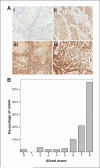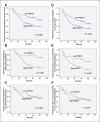High XRCC1 protein expression is associated with poorer survival in patients with head and neck squamous cell carcinoma
- PMID: 21908577
- PMCID: PMC3725262
- DOI: 10.1158/1078-0432.CCR-10-1604
High XRCC1 protein expression is associated with poorer survival in patients with head and neck squamous cell carcinoma
Abstract
Purpose: We evaluated X-ray repair complementing defective repair in Chinese hamster cells 1 (XRCC1) protein in head and neck squamous cell carcinoma (HNSCC) patients in association with outcome.
Experimental design: XRCC1 protein expression was assessed by immunohistochemical (IHC) staining of pretreatment tissue samples in 138 consecutive HNSCC patients treated with surgery (n = 31), radiation (15), surgery and radiation (23), surgery and adjuvant chemoradiation (17), primary chemoradiation (51), and palliative measures (1).
Results: Patients with high XRCC1 expression by IHC (n = 77) compared with patients with low XRCC1 expression (n = 60) had poorer median overall survival (OS; 41.0 months vs. OS not reached, P = 0.009) and poorer progression-free survival (28.0 months vs. 73.0 months, P = 0.031). This association was primarily due to patients who received chemoradiation (median OS of high- and low-XRCC1 expression patients, 35.5 months and not reached respectively, HR 3.48; 95% CI: 1.44-8.38; P = 0.006). In patients treated with nonchemoradiation modalities, there was no survival difference by XRCC1 expression. In multivariable analysis, high XRCC1 expression and p16(INK4a)-positive status were independently associated with survival in the overall study population (HR = 2.62; 95% CI: 1.52-4.52; P < 0.001 and HR = 0.21; 95% CI: 0.06-0.71; P = 0.012, respectively) and among chemoradiation patients (HR = 6.02; 95% CI: 2.36-15.37; P < 0.001 and HR = 0.26; 95% CI: 0.08-0.92, respectively; P = 0.037).
Conclusions: In HNSCC, high XRCC1 protein expression is associated with poorer survival, particularly in patients receiving chemoradiation. Future validation of these findings may enable identification of HNSCC expressing patients who benefit from chemoradiation treatment.
©2011 AACR.
Figures



References
-
- Parkin DM, Bray F, Ferlay J, Pisani P. Global cancer statistics, 2002. CA Cancer J Clin. 2005;55:74–108. - PubMed
-
- Burri RJ, Lee NY. Concurrent chemotherapy and radiotherapy for head and neck cancer. Expert Rev Anticancer Ther. 2009;9:293–302. - PubMed
-
- Thompson LH, West MG. XRCC1 keeps DNA from getting stranded. Mutat Res. 2000;459:1–18. - PubMed
-
- Zhang R, Niu Y, Zhou Y. Increase the cisplatin cytotoxicity and cisplatin-induced DNA damage in HEpG2 cells by XRCC1 abrogation related mechanisms. Toxicol Lett. 2010;192:108–14. - PubMed
Publication types
MeSH terms
Substances
Grants and funding
LinkOut - more resources
Full Text Sources
Medical

